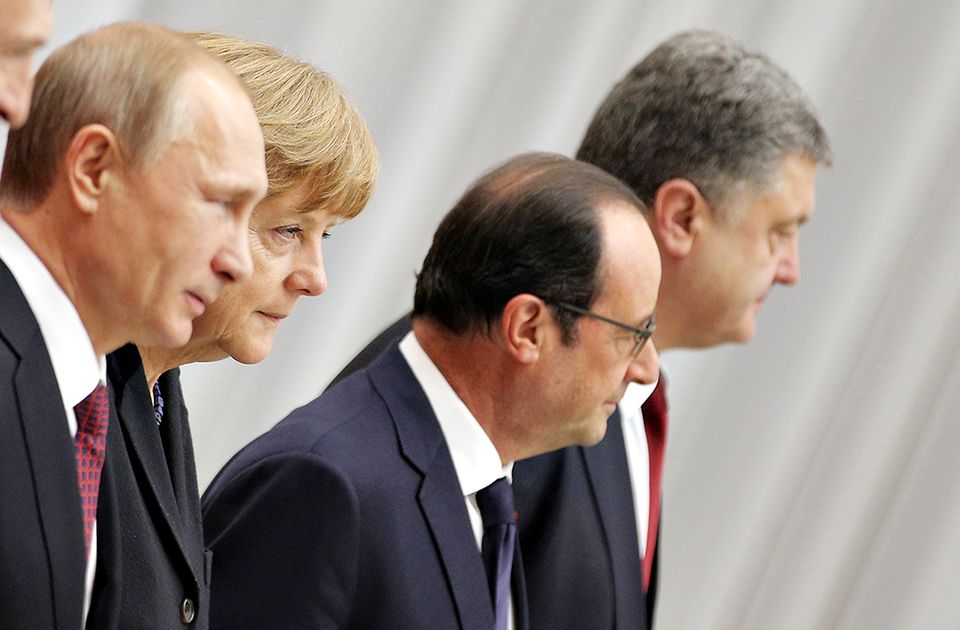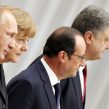
Minsk Two Armistice Rewards Russia’s Aggression, Mortgages Ukraine’s Future (Part One)
Publication: Eurasia Daily Monitor Volume: 12 Issue: 29
By:

Russian President Vladimir Putin, German Chancellor Angela Merkel and French President Francois Hollande have jointly prevailed on Ukraine to sign another armistice with Russia’s proxy forces operating in Ukraine’s east (Kremlin.ru, Osce.org, February 12; see EDM, February 12).
Signed on February 12, in Minsk, Belarus, the new armistice agreement (Minsk Two) purports to aim at implementing the Minsk armistice agreements of September 5 and September 19, 2014 (cumulatively Minsk One), which the Russian side has torn apart since then. Minsk Two’s pretense to implement Minsk One is misleading, however. The Minsk Two agreement’s military and security clauses leave Ukraine in a position of even greater vulnerability; while the political clauses threaten (more directly than Minsk One) to insert Russia through its proxies into Ukraine’s constitutional processes. Minsk Two is so heavy on political content that it can no longer be simply described as an armistice agreement.
An accompanying political declaration, bearing Ukrainian President Petro Poroshenko’s signature alongside those of Putin, Merkel and Hollande, envisages re-negotiating the European Union-Ukraine free trade agreement, turning this bilateral EU-Ukraine process into a trilateral EU-Ukraine-Russia process, seeking “practical solutions to the issues of concern to Russia” (Kremlin.ru, Osce.org, February 12). This would imply a Russian voice and potential veto affecting Ukraine’s European choice.
The pretense of implementing Minsk One has made it easier for Moscow to impose, Berlin to accept (with Paris in tow), and Kyiv to swallow the signatures of the Donetsk and Luhansk “people’s republics’” leaders on the Minsk Two agreement. Vladimir Zakharchenko and Igor Plotnitsky are signatories to Minsk Two alongside Ukraine’s former president Leonid Kuchma, Russia’s Ambassador Mikhail Zurabov, and Swiss diplomat Heidi Tagliavini as the Organization for Security and Cooperation in Europe’s (OSCE) representative, now reporting to Serbia’s chairmanship of the OSCE. Zakharchenko’s and Plotnitsky’s signatures do not include their “presidential” titles yet; but the Minsk Two agreement sets the stage for a continuous process of legitimizing the “DPR”-“LPR” and their leaders de facto.
At no point does the agreement acknowledge Russia’s role as a party to the conflict, or the presence of Russian weaponry and military personnel on Ukraine’s territory.
Article 1 of the new agreement stipulates an “immediate ceasefire […] starting at 00:00 hrs on February 15.” A glaring contradiction exists, however, between an “immediate start” and when it will actually take effect—that is, three days later. Russia needs this delay to enable its proxies to capture the Debaltseve railway and highway juncture. The Russian forces’ advance toward Debaltseve was already, in itself, a breach of Minsk One. The capture of Debaltseve would be a further breach, instead of “implementing” that armistice.
Under Article 2, Ukrainian forces would withdraw at specified distances from the currently existing, “de facto front line,” whereas the “Donetsk and Luhansk” forces would withdraw from the September 19, 2014 Minsk One front line. The now-existing de facto line took shape through Russian (“Donetsk-Luhansk”) military advances, incorporating additional bits of territory, again in breach of Minsk One, and not corrected by Minsk Two. Russian and proxy forces are to withdraw their heavy weaponry from those recently captured areas, but are not required to withdraw the troops; thus, they will keep their gains in violation of Minsk One, instead of “implementing Minsk One.” Ukrainian withdrawal from this new line puts Ukrainian forces at longer distances from contested areas, such as Debaltseve or the approaches to Mariupol; while leaving such areas within easier reach of Russian and proxy forces.
Article 3 of the new agreement tasks the OSCE with monitoring and verifying the ceasefire regime and the troop withdrawals (these are to be completed within 14 days, counting from February 16—see above). The OSCE should supposedly use “all necessary technical means, including satellites, unmanned aerial vehicles [UAV], radar systems and so on.” The OSCE, however, possesses such technical means to a negligible extent and lacks financing to acquire them, or qualified personnel to operate them. The OSCE has seen its handful of UAVs shot at and interfered with by Russian and/or proxy forces, and its personnel denied access or even kidnapped by those forces. The OSCE can only operate within a mandate that must be pre-negotiated with Russia in every technical detail. OSCE monitoring and verification means no reliable monitoring or verification. It amounts to a free hand for Russia, unless Russia is restrained by factors other than the OSCE.
Under Articles 4 and 12, from the first day following the troop withdrawals (see above), the Ukrainian government and the Donetsk-Luhansk authorities should “start a dialogue on the modalities of holding local elections in accordance with Ukrainian legislation […] as well as on a future regime [sic] of certain areas in the Donetsk and Luhansk oblasts [provinces].” The reference is to the Russian-controlled areas (de facto the Donetsk and Luhansk “people’s republics”), “defined by the [armistice] line, as set by the September 2014 Minsk memorandum.” The Ukrainian legislation being invoked is the electoral law as well as the “law on procedures for local self-administration in certain areas of the Donetsk and Luhansk provinces” (i.e., the Russian-controlled areas), adopted by the Ukrainian parliament in September 2014 (see EDM, September 19, 2014; September 23, 2014).
Further, under articles 4 and 12, the Minsk Two agreement stipulates that Kyiv must discuss and agree with the Donetsk-Luhansk “representatives” (i.e., Zakharchenko and Plotnitsky or their envoys) about the modalities of local elections to be held in the Russian-controlled areas. The Donetsk-Luhansk local elections shall, supposedly, “be held in compliance with OSCE standards and monitored by the OSCE.”
All this implies: First, blocking or veto power for Russia’s proxies to override the legislation of a recognized democratic state, as the new Ukraine is. Second, it signifies a political decision by Germany (with France tagging along) to satisfy the Kremlin in legitimizing the Donetsk-Luhansk authorities as duly elected. And third, it implies expecting the OSCE to bless such “elections.” In an Addendum Note (Russian: Primechanie), those Russian-controlled “certain districts” would set up their own “people’s police detachments” (Ukraine’s consent is clearly expected and implied).
This amounts to a Western breach of faith with Ukraine on several counts. First, the Minsk One agreement and the Ukrainian law had envisaged those “procedures for local self-administration in certain areas of the Donetsk and Luhansk provinces,” provided that these refrain from staging “presidential” and “parliamentary” elections. But they did stage such “elections” on November 2, 2014, thereby invalidating that part of the Minsk One agreement. Again, instead of correcting that situation (implementing Minsk One), the Minsk Two agreement ratifies that violation of Minsk One, and marks a further step toward legitimizing the Russian-controlled enclaves in Ukraine’s territory. Furthermore, Ukraine’s law on “procedures for local self-administration in certain areas of the Donetsk and Luhansk provinces” had stipulated that any local police units would be subordinated to Ukraine’s law enforcement agencies. Minsk Two now invokes that Ukrainian law but ignores that part of the law. Even US Secretary of State John Kerry, on his February 5 visit to Kyiv (State.gov, February 5), publicly called on Ukraine to apply that law, despite the Russian side’s actions (see above) that had relieved Ukraine of that supposed obligation.




